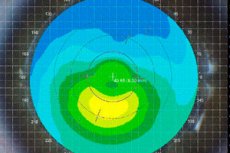Keratometry of the cornea
Last reviewed: 23.04.2024

All iLive content is medically reviewed or fact checked to ensure as much factual accuracy as possible.
We have strict sourcing guidelines and only link to reputable media sites, academic research institutions and, whenever possible, medically peer reviewed studies. Note that the numbers in parentheses ([1], [2], etc.) are clickable links to these studies.
If you feel that any of our content is inaccurate, out-of-date, or otherwise questionable, please select it and press Ctrl + Enter.

Kerometry of the cornea is the measurement of the curvature of the axial meridians of the anterior surface of the cornea.
Optical principles of keratometry
- The cornea is a convex lens with a constant curvature value for each meridian.
- Thanks to the properties of the cornea, the points designed by the apparatus on the surface of the cornea (two vertical and two horizontal) are reflected, which makes it possible to measure the radius of curvature (in mm) and convert it into diopters.
Restrictions of keratometry
- Keratometry makes it possible to measure the surface of the cornea, limited to only four points spaced about 3 mm apart, but does not provide information about the central and peripheral zones of the cornea in relation to these points.
- Moderate abnormalities in the surface of the cornea can cause distortion and decrease in measurement accuracy, so the method is practically not used to measure non-spherical cylinders found in refractive surgery, with keratoconus and other severe corneal pathologies.
Investigation of corneal topography using computer videokeratoscopy allows obtaining a color map of the surface of the cornea, calculating the indices of two main meridians (refractive power in diopters and their axes).
Indications for the study of corneal topography
- Quantification of abnormal astigmatism and changes in the surface of the cornea associated with the wearing of contact lenses.
- Early diagnosis of keratoconus, as the diagnosis of its initial and preclinical manifestations is significantly hampered.
- Postoperative assessment of corneal topography after refractive surgery, keratoplasty, or cataract extraction.
Color Scales
- Absolute scale: given endpoints; each color of the scale characterizes a certain diopter interval. Usually the map of the topography of the normal cornea is in the yellow-green spectrum. Indicators of this scale should be used in the comparative characteristic of changes in time.
- The relative scale is not fixed and varies according to the dioptric range of the particular cornea. It is important to study the scale before interpreting the map.

Evaluation of results
Interpretation of the keratotopogram is always based on practice. It is necessary to answer the following questions:
- What scale is used in the keratopogram?
- Is the scale appropriate?
- Is the keratopogram reliable?
- What is the position of the pupil relative to the curvature pattern on the screen?
Who to contact?


 [
[